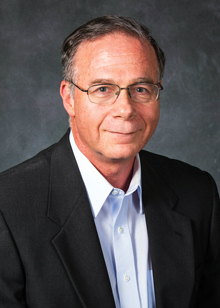“When I was a kid, I thought it would be cool to build things—and I was an avid follower of the space program,” says Ted Goetz. As chief engineer of the International Space Station (ISS), he got to combine those interests.

He prepared for just that sort of role at MIT, where he majored in mechanical engineering and studied nuclear engineering and economics. But opportunities in aerospace were scarce when he graduated, in part because of the international oil crisis and subsequent economic slump. So Goetz focused on heat transfer and thermodynamics, earning an MBA at Pepperdine and a master’s in mechanical engineering at the University of California, Berkeley. He began his career in energy research and development at Rockwell International, working on solar, geothermal, ocean thermal, and nuclear power.
“What I learned in 10 years in terrestrial power proved a solid foundation for contributing to the space station,” says Goetz. So when the opportunity arose, he was ready to tackle the wide range of technical issues involved in producing and maintaining the ISS, first through Rockwell, and then through Boeing when it bought out Rockwell’s space business in the 1990s. He initially served as chief engineer for the ISS power system and then as manager for ISS vehicle integration. In 1999 he took on the chief engineer role.
When engineering for an extraterrestrial work environment, Goetz had to design systems that could endure the punishing cold of space and keep the need for staff repairs to a minimum. Given those constraints, tools in space lagged behind standard equipment on Earth. For example, Goetz oversaw a station that launched with a modest 300-megabyte hard drive at a time when gigabyte drives were the norm.
During his career, space travel evolved from a breathtaking exercise in exploration to something more prosaic, with an expanding commercial mission. Yet beyond ensuring safe travel for astronauts, an enduring engineering challenge remains: deliver maximum capacity in the smallest possible package that can accommodate multiple failures—at declining cost.
Today, Goetz is chief engineer for Boeing’s Commercial Crew Transportation System, working to develop systems that will deliver crew members and cargo into low Earth orbit for NASA and commercial clients. That means, he says, balancing the demands of zero-gravity space travel with the realities of the bottom line.
Goetz and his wife, Mary Ann, live in Houston and have four grown daughters. While they have never visited the space station, they travel widely on Earth.
Keep Reading
Most Popular
Large language models can do jaw-dropping things. But nobody knows exactly why.
And that's a problem. Figuring it out is one of the biggest scientific puzzles of our time and a crucial step towards controlling more powerful future models.
The problem with plug-in hybrids? Their drivers.
Plug-in hybrids are often sold as a transition to EVs, but new data from Europe shows we’re still underestimating the emissions they produce.
Google DeepMind’s new generative model makes Super Mario–like games from scratch
Genie learns how to control games by watching hours and hours of video. It could help train next-gen robots too.
How scientists traced a mysterious covid case back to six toilets
When wastewater surveillance turns into a hunt for a single infected individual, the ethics get tricky.
Stay connected
Get the latest updates from
MIT Technology Review
Discover special offers, top stories, upcoming events, and more.